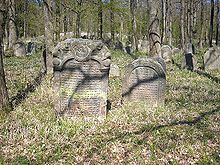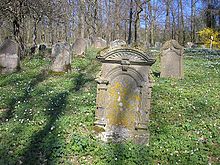Jewish cemetery (Ebern)
The Ebern Jewish cemetery is located north of the former district town of Ebern ( Haßberge district , Lower Franconia ) behind an extensive factory site. The Jewish cemetery , laid out in the 17th century, served as a burial place for the Jewish population of the city and the surrounding area until 1912.
history
City of Ebern
The settlement of Jews in the town of Ebern can be documented for the first time in 1433. Bishop Johann von Brunn had allowed the citizens to receive and withhold protection funds three years after the great city fire in order to promote the reconstruction of the city. In 1633, the Jews living in the city bought the property in the Paradies hall on the western slope of the Steinberg as a burial place. In 1639, however, the small community was expelled from the official city of the Hochstift Würzburg again .
The cemetery, hidden in a side valley in front of the city, served as the central burial place ( Jewish association cemetery ) for the surrounding Jewish communities after the eviction of the few Ebern Jewish families . Until the secularization , Jews were admitted and expelled several times within the city walls . Usually two families lived in boars at the same time.
In 1622, however, the citizenship refused to allow Jewish settlement. They have had bad experiences with the Jew Michel, who is said to have led his horses past the parish church during the Sunday service . Furthermore, Michel was even accused of poisoning a well and a relaxed lifestyle. A year later, Prince-Bishop Philipp Adolf von Ehrenberg expelled all Jews from the diocese .
As early as 1659, however, the bishopric was asked to resettle. The citizenry hoped for additional income from the protection and special money that was incurred, with which the damage of the Thirty Years' War should be alleviated.
Surrounding area
After the extensive depopulation of the region during the Thirty Years' War, the Protestant imperial knighthood of the Haßberge welcomed many Jews as well as numerous Christian settlers. These “protective Jews” were partly expelled from the cities of the Würzburg monastery because they were u. a. made responsible for the outbreak of war-related epidemics such as the plague . The settlement of this population group was a lucrative source of income for the respective territorial lords . In addition to protection money, New Year's money, extra money, kosher money and road construction contributions had to be raised.
In 1683 the Jewish communities in the city and the surrounding area were given permission to enlarge and wall the Ebern cemetery. The last burial took place there in 1912. This enclosure wall was partially demolished during the Nazi era and used for road construction. In 1962 the city renewed the walling.
The larger Jewish communities in the Haßberge built their own cemeteries in the 18th or 19th centuries. The Jewish cemetery in Burgpreppach was established as early as 1708, and the Jewish cemetery near Ermershausen in 1832 . In 1835 the Jewish cemetery was laid out in Memmelsdorf near Untermerzbach . In 1841 the small Jewish cemetery in Untermerzbach was added.
description
The cemetery is located northeast of the FTE automotive premises on the slope of the Steinberg. The approximately 132.50 ares large area is partially surrounded by an approximately 1.50 meter high sandstone wall. The parts of the wall that were demolished during the Nazi era were renewed with precast concrete elements.
The modern wrought iron entrance gate is locked for security reasons. The key is issued by the city administration.
Today about 1200 tombstones ( Mazewot ) are still preserved, which are almost exclusively inscribed in Hebrew because of the orthodox orientation of the communities in the surrounding area . Only below the entrance do some of the more recent grave monuments bear bilingual inscriptions.
The older stones were mostly made from local Rhätsandstein and often have rich symbolic decorations . Some particularly lavishly decorated tombstones show baroque styles. Particularly noteworthy is a tombstone with angel heads and a Shabbat lamp .
The stones in the newer part of the cemetery bear the typical historicizing decorative elements of the 19th century. In addition to classical forms, one can recognize neo-Romanesque columns and neo-Gothic tracery .
A few graves seem to be visited occasionally by relatives. This is indicated by the small reading stones that are placed on the tombs according to Jewish custom. However, many of these stones lie on the grave monuments in the entrance area and were probably left by non-Jewish visitors interested in cultural history.
Web links
- "The stones on paradise". Documentation project of the Institute for Jewish Studies at the Heinrich Heine University Düsseldorf on the Jewish cemetery in Ebern.
- Ebern Jewish cemetery near Alemannia Judaica
- Ebern Jewish cemetery at the central archive for research into the history of Jews in Germany
- The Jewish cemetery in Ebern near the House of Bavarian History
literature
- Isolde Maierhöfer: Boars . In: Historical Atlas of Bavaria, Part Franconia, Volume 1. No. 15 . Munich 1964.
- Isolde Maierhöfer: Ebern - picture of a Franconian small town . Weissenhorn 1980.
- Michael Trüger: The Jewish cemetery in Ebern . In: Landesverband der Israelitischen Kultusgemeinden in Bavaria , 11th year, No. 70, 1996, p. 28.
- Lothar Mayer: Jewish cemeteries in Lower Franconia . Michael Imhof Verlag, Petersberg 2010, pp. 43-47, ISBN 978-3-86568-071-6 .
- Stefan Rohrbacher: Stones on Paradise. The Jewish cemetery in Ebern. Boars 2016.
Coordinates: 50 ° 6 ′ 20.7 ″ N , 10 ° 47 ′ 39.8 ″ E





